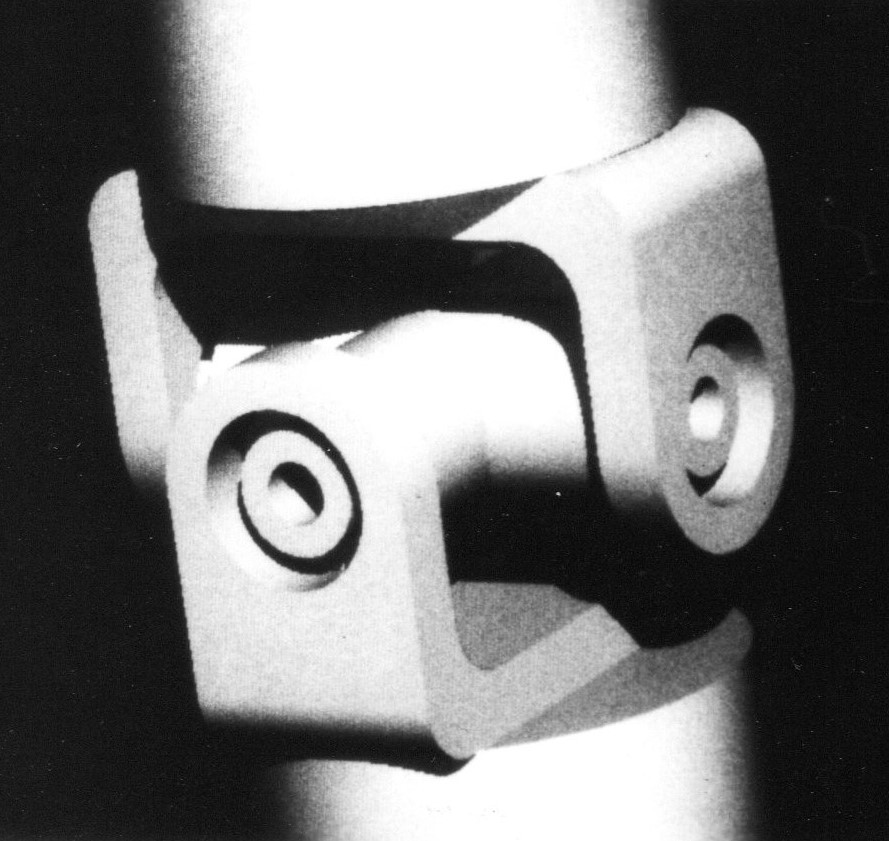|
Brush (video Game)
Brushes are templates used in some 3D video game engines, such as the Quake engine, its derivatives the GoldSrc and Source game engines, or the Unreal Engine, to construct levels. Brushes can be primitive shapes (such as cubes, spheres and cones), pre-defined shapes (such as staircases), or custom shapes (such as prisms and other polyhedra). In order to describe these shapes mathematically, each brush is made up of planes that define its boundaries. A plane can be represented by an equation in 3D space, which looks like this: ax+by+cz+d=0 This equation describes a single flat surface (or plane) in 3D space, where a, b, and c are coefficients that determine the orientation of the plane, and d is a constant that shifts the plane along its axis. To construct a brush, the game engine uses multiple planes working together. For example, a cube can be defined by six planes, each restricting space within a certain region. Here’s how a set of three planes would be represented mathem ... [...More Info...] [...Related Items...] OR: [Wikipedia] [Google] [Baidu] |
3D Computer Graphics
3D computer graphics, sometimes called Computer-generated imagery, CGI, 3D-CGI or three-dimensional Computer-generated imagery, computer graphics, are graphics that use a three-dimensional representation of geometric data (often Cartesian coordinate system#Cartesian coordinates in three dimensions, Cartesian) that is stored in the computer for the purposes of performing calculations and rendering digital images, usually 2D images but sometimes 3D images. The resulting images may be stored for viewing later (possibly as an Computer animation, animation) or displayed in Real-time computer graphics, real time. 3D computer graphics, contrary to what the name suggests, are most often displayed on two-dimensional displays. Unlike 3D film and similar techniques, the result is two-dimensional, without visual depth perception, depth. More often, 3D graphics are being displayed on 3D displays, like in virtual reality systems. 3D graphics stand in contrast to 2D computer graphics which t ... [...More Info...] [...Related Items...] OR: [Wikipedia] [Google] [Baidu] |
Binary Space Partitioning
In computer science, binary space partitioning (BSP) is a method for space partitioning which recursively subdivides a Euclidean space into two convex sets by using hyperplanes as partitions. This process of subdividing gives rise to a representation of objects within the space in the form of a Tree (data structure), tree data structure known as a BSP tree. Binary space partitioning was developed in the context of 3D computer graphics in 1969. The structure of a BSP tree is useful in rendering (computer graphics), rendering because it can efficiently give spatial information about the objects in a scene, such as objects being ordered from front-to-back with respect to a viewer at a given location. Other applications of BSP include: performing geometrical operations with shapes (constructive solid geometry) in Computer-aided design, CAD, collision detection in robotics and 3D video games, ray tracing (graphics), ray tracing, virtual landscape simulation, and other applications tha ... [...More Info...] [...Related Items...] OR: [Wikipedia] [Google] [Baidu] |
Raycasting
Ray casting is the methodological basis for 3D CAD/CAM solid modeling and image rendering. It is essentially the same as ray tracing for computer graphics where virtual light rays are "cast" or "traced" on their path from the focal point of a camera through each pixel in the camera sensor to determine what is visible along the ray in the 3D scene. The term "Ray Casting" was introduced by Scott Roth while at the General Motors Research Labs from 1978–1980. His paper, "Ray Casting for Modeling Solids", describes modeled solid objects by combining primitive solids, such as blocks and cylinders, using the set operators union (+), intersection (&), and difference (−). The general idea of using these binary operators for solid modeling is largely due to Voelcker and Requicha's geometric modelling group at the University of Rochester. See '' solid modeling'' for a broad overview of solid modeling methods. Before ray casting (and ray tracing), computer graphics algorithms projected s ... [...More Info...] [...Related Items...] OR: [Wikipedia] [Google] [Baidu] |
Quake (video Game)
''Quake'' is a 1996 first-person shooter game developed by id Software and published by GT Interactive. The first game in the ''Quake'' series, it was originally released for MS-DOS and Microsoft Windows, followed by Mac OS, Linux and Sega Saturn in 1997 and Nintendo 64 in 1998. The game's plot is centered around teleportation experiments, dubbed slipgates, which have resulted in an unforeseen invasion of Earth by a hostile force codenamed Quake, which commands a vast army of monsters. The player takes the role of a soldier (later dubbed Ranger), whose mission is to travel through the slipgates in order to find and destroy the source of the invasion. The game is split between futuristic military bases and medieval, gothic environments, featuring both science fiction and fantasy weaponry and enemies as the player battles possessed soldiers and demonic beasts such as ogres or armor-clad knights. ''Quake'' heavily takes inspiration from gothic fiction and in particular the wor ... [...More Info...] [...Related Items...] OR: [Wikipedia] [Google] [Baidu] |
Epic Games
Epic Games, Inc. is an American Video game developer, video game and software development, software developer and video game publisher, publisher based in Cary, North Carolina. The company was founded by Tim Sweeney (game developer), Tim Sweeney as Potomac Computer Systems in 1991, originally located in his parents' house in Potomac, Maryland. Following its first commercial video game release, ''ZZT'' (1991), the company became Epic MegaGames, Inc. in early 1992 and brought on Mark Rein (software executive), Mark Rein, who has been its vice president since. After moving the headquarters to Cary in 1999, the studio changed its name to Epic Games. Epic Games developed Unreal Engine, a commercially available game engine which also powers its internally developed video games like ''Fortnite'' and the ''Unreal (video game series), Unreal'', ''Gears of War'', and ''Infinity Blade'' series. In 2014, Unreal Engine was named the "most successful videogame engine" by ''Guinness World Rec ... [...More Info...] [...Related Items...] OR: [Wikipedia] [Google] [Baidu] |
Binary Space Partitioning
In computer science, binary space partitioning (BSP) is a method for space partitioning which recursively subdivides a Euclidean space into two convex sets by using hyperplanes as partitions. This process of subdividing gives rise to a representation of objects within the space in the form of a Tree (data structure), tree data structure known as a BSP tree. Binary space partitioning was developed in the context of 3D computer graphics in 1969. The structure of a BSP tree is useful in rendering (computer graphics), rendering because it can efficiently give spatial information about the objects in a scene, such as objects being ordered from front-to-back with respect to a viewer at a given location. Other applications of BSP include: performing geometrical operations with shapes (constructive solid geometry) in Computer-aided design, CAD, collision detection in robotics and 3D video games, ray tracing (graphics), ray tracing, virtual landscape simulation, and other applications tha ... [...More Info...] [...Related Items...] OR: [Wikipedia] [Google] [Baidu] |
Polyhedra
In geometry, a polyhedron (: polyhedra or polyhedrons; ) is a three-dimensional figure with flat polygonal faces, straight edges and sharp corners or vertices. The term "polyhedron" may refer either to a solid figure or to its boundary surface. The terms solid polyhedron and polyhedral surface are commonly used to distinguish the two concepts. Also, the term ''polyhedron'' is often used to refer implicitly to the whole structure formed by a solid polyhedron, its polyhedral surface, its faces, its edges, and its vertices. There are many definitions of polyhedron. Nevertheless, the polyhedron is typically understood as a generalization of a two-dimensional polygon and a three-dimensional specialization of a polytope, a more general concept in any number of dimensions. Polyhedra have several general characteristics that include the number of faces, topological classification by Euler characteristic, duality, vertex figures, surface area, volume, interior lines, Dehn invari ... [...More Info...] [...Related Items...] OR: [Wikipedia] [Google] [Baidu] |
Game Engine
A game engine is a software framework primarily designed for the development of video games which generally includes relevant libraries and support programs such as a level editor. The "engine" terminology is akin to the term " software engine" used more widely in the software industry. ''Game engine'' can also refer to the development software supporting this framework, typically a suite of tools and features for developing games. Developers can use game engines to construct games for video game consoles and other types of computers. The core functionality typically provided by a game engine may include a rendering engine ("renderer") for 2D or 3D graphics, a physics engine or collision detection (and collision response), sound, scripting, animation, artificial intelligence, networking, streaming, memory management, threading, localization support, scene graph, and video support for cinematics. Game engine implementers often economize on the process of game developme ... [...More Info...] [...Related Items...] OR: [Wikipedia] [Google] [Baidu] |
Geometric Primitive
In vector computer graphics, CAD systems, and geographic information systems, a geometric primitive (or prim) is the simplest (i.e. 'atomic' or irreducible) geometric shape that the system can handle (draw, store). Sometimes the subroutines that draw the corresponding objects are called "geometric primitives" as well. The most "primitive" primitives are point and straight line segments, which were all that early vector graphics systems had. In constructive solid geometry, primitives are simple geometric shapes such as a cube, cylinder, sphere, cone, pyramid, torus. Modern 2D computer graphics systems may operate with primitives which are curves (segments of straight lines, circles and more complicated curves), as well as shapes (boxes, arbitrary polygons, circles). A common set of two-dimensional primitives includes lines, points, and polygons, although some people prefer to consider triangles primitives, because every polygon can be constructed from triangles. All o ... [...More Info...] [...Related Items...] OR: [Wikipedia] [Google] [Baidu] |
Level (video Gaming)
In video games, a level (also referred to as a map, mission, stage, course, or round in some older games) is any space available to the player during the course of completion of an objective. Video game levels generally have progressively increasing difficulty to appeal to players with different skill levels. Each level may present new concepts and challenges to keep a player's interest high to play for a long time. In games with linear progression, levels are areas of a larger world, such as Green Hill Zone. Games may also feature interconnected levels, representing locations. Although the challenge in a game is often to defeat some sort of character, levels are sometimes designed with a movement challenge, such as a jumping puzzle, a form of obstacle course. Players must judge the distance between platforms or ledges and safely jump between them to reach the next area. These puzzles can slow the momentum down for players of fast action games; the first ''Half-Life'''s penul ... [...More Info...] [...Related Items...] OR: [Wikipedia] [Google] [Baidu] |




